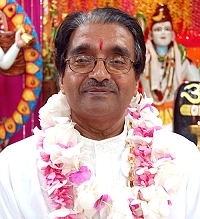From a satsang with Paramacharya of SWAHA, H.H. Pt. Hardeo Persad
As we reflect on the recent celebration of Indian Arrival Day, it is a moment to ponder the profound source of strength and resilience that sustained many of our ancestors, the Ramaayan. The ancient epic, rich in symbolism and wisdom, provided them with the courage to persevere in new and challenging environments. It continues to offer eternal guidance on the virtues essential for a meaningful and fulfilling life.
The Ramaayan narrates the story of crown prince Shree Raam, Sita Maataa and Lakshmanji, who were exiled to the forest for 14 years. This narrative is laden with allegorical significance that imparts deep teachings on spirituality and virtuous conduct.
Ayodhya, the kingdom from which Shree Raam was exiled, represents the human body. King Dasrath symbolises the ten senses or human faculties: the five senses of perception and the five organs of action. His three queens embody the three gunas: sattva (goodness), rajas (passion) and tamas (ignorance). In this allegory, Shree Raam personifies the perfection of spirituality and wisdom (gyaan); Bharath, devotion (bhakti yoga); Lakshman, dutiful action (raja yoga) and Shatrughan, selfless service (karma yoga).
A pivotal distinction made in the Ramaayan is between spirituality and religiousness. Spirituality encompasses our intrinsic values and qualities, such as truthfulness and integrity, which transcend religious boundaries. Unlike materialism (rajas prakriti), spirituality remains constant, irrespective of our circumstances. The narrative shows how materialism inherently banishes spirituality, as symbolised by Shree Raam’s exile.
Spirituality is universal, accessible to all, including atheists, if they adhere to the right values. The Ramaayan emphasises six forms of spiritual wealth (Shat Sampath): tranquillity of mind, serenity, control of the senses, endurance, faith and renunciation of selfish desires. These spiritual treasures accompany us beyond this life, enabling us to master materialism rather than being enslaved by it.
The colours red and white symbolise materialism and spirituality, respectively. Their blend creates pink, representing the divine mother Lakshmi, symbolising a perfect balance between the two. This balance is crucial as life can swiftly transition from opulence to austerity, as illustrated by the abrupt shift from palace life to forest dwelling for Shree Raam and his family.
Shree Raam exemplifies the ideal of living with dispassion, unaffected by external circumstances. Described as lotus-eyed and lotus-bodied, he remains pure and untouched by the impurities around him, much like the lotus that extracts its nutrients from muddy waters yet remains unblemished by it. This symbolises the need to extract what is necessary from the world while maintaining internal purity and perfection.
The Ramaayan teaches us to feel others’ pain as our own and to share in their joys. Our happiness or sorrow is a consequence of our own actions (karmas), and understanding this leads to a more compassionate and interconnected existence.
The world is ever-changing and temporary, a manifestation of the Lord’s delusive potency, maayaa. However, true devotion to God can transcend this illusion, guiding us towards eternal truths and spiritual enlightenment.
Through the virtues and principles embodied in the Ramaayan, we learn to strive for a life of balance, compassion and spiritual wisdom, transcending the dualities of happiness and sorrow, and recognising our oneness with the divine.


